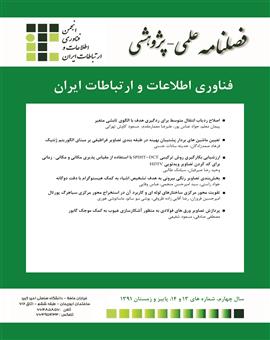تقویت محور مرکزی سازه های لوله ای و کاربرد آن در استخراج محور مرکزی ورید پورتال
محورهای موضوعی : عمومىامیرحسین فروزان 1 , رضا آقایی زاده ظروفی 2 , یوشی¬نبو ساتو 3 , ماساتوشی هوری 4
1 - دانشگاه شاهد
2 - دانشگاه تهران
3 - دانشگاه شاهد
4 - دانشگاه شاهد
کلید واژه: استخراج ساختارهای لوله¬ای, استخراج محور مرکزی سیاهرگ پورتال, آنالیز تصاویر سی¬تی¬اسکن کبد, پردازش تصاویر پزشکی,
چکیده مقاله :
در این مقاله با ارائه توصیف جدیدی از ویژگی نقاط محور مرکزی ساختارهای لوله ای، روشی برای تقویت این ساختارها پیشنهاد شده است. در این روش، در یک چارچوب چندمقیاسی و با استفاده از بردارهای ویژه ماتریس هسین نقاط تصویر، فاصله هر نقطه را از لبه های تصویر به دست می-آوریم. برای نقاطی که روی محور مرکزی قرار دارند این فاصله از دوسر هر راستای دلخواه متقارن است. در این مرحله با نمونه برداری فاصله هر نقطه از لبه های تصویر در راستاهای مختلف، به نقاطی که تقارن بیشتری دارند مقدار بیشتری نسبت می دهیم. در مرحله بعد برای تقویت محور مرکزی لوله ها، از یک فیلتر براساس روش Pock استفاده می کنیم. ارزیابی روش پیشنهادی با استفاده از تصاویر فانتوم دوبعدی و سه بعدی و داده-های پزشکی به صورت کیفی و کمی با معیارهای حداکثر خطای تعیین محور مرکزی و نرخ آشکارسازی انجام گرفته است که مزیت این روش را به روش های موجود نشان می دهد
In this article, by presenting a new description of the characteristic of the central axis points of tubular structures, a method to strengthen these structures is proposed. In this method, in a multi-scale framework and using special vectors of the Hessian matrix of the image points, we obtain the distance of each point from the edges of the image. For the points located on the central axis, this distance from the bisector of any arbitrary direction is symmetrical. In this step, by sampling the distance of each point from the edges of the image in different directions, we assign a greater value to the points that have more symmetry. In the next step, we use a filter based on the Pock method to strengthen the central axis of the tubes. The evaluation of the proposed method has been done using two-dimensional and three-dimensional phantom images and medical data qualitatively and quantitatively with the criteria of maximum error in determining the central axis and detection rate, which shows the advantage of this method over the existing methods.
[1]. E. N. Marieb, Human Anatomy and Physiology. The Benjamin/Cummings Publishing Company, 1992, pp. 796-797.
[2]. A. M. R. Agur, Atlas of Anatomy. Canada: Williams and Wilkins, 1991, p.79.
[3]. J. H. D. Fasel et al., “Segmental Anatomy of the Liver: Poor Correlation with CT,” Radiology, vol. 206, no. 1, pp. 151-156, 1998.
[4]. D. Lesage et al., “A Review of 3D Vessel Lumen Segmentation Techniques: Models, Features and Extraction Schemes,” Medical Image Analysis, vol. 13, no. 6, pp. 819–845, 2009.
[5]. C. Kirbas and F. Quek, “A Review of Vessel Extraction Techniques and Algorithms,” ACM Computing Surveys, vol. 36, no. 2, pp. 81–121, 2004.
[6]. A.F. Frangi et al., “Multiscale vessel enhancement filtering,” In Proc. 1st MICCAI, 1998, pp. 130-137.
[7]. T. Pock et al., “Multiscale Medialness for Robust Segmentation of 3D Tubular Structures,” 10th computer vision winter workshop, 2005, pp. 93-102.
[8]. S. Wörz and K. Rohr, “Segmentation and Quantification of Human Vessels Using a 3-D Cylindrical Intensity Model,” IEEE Trans. on Image Processing, vol. 16, no.8, pp. 1994-2004, 2007.
[9]. G. Agam, S.G. Armato III, and C. Wu, “Vessel-tree reconstruction in thoracic CT scans with application to nodule detection,” IEEE Transactions on Medical Imaging, vol. 24, no. 4, 2005.
[10]. V. Mahadevan, H. Narasimha-Iyer, B. Roysam, H.L. Tanenbaum, “Robust model-based vasculature detection in noisy biomedical images. IEEE Trans. Inf. Technol. Biomed., vol. 8, no. 3, pp. 360–375, 2004.
[10]. J. Lee, P. Beighley, E. Ritman, N. Smith, “Automatic segmentation of 3D micro-CT coronary vascular images,” Med. Imag. Anal., vol. 11, no. 6, pp. 630–647, 2007.
[11]. X. Qian, M.P. Brennan, D.P. Dione, et al., “A non-parametric vessel detection method for complex vascular structures,” Med. Imag. Anal., vol. 13, issue 1, pp. 49-61, 2009.
[12]. K. Krissian, G. Malandain, N. Ayache, R. Vaillant and Y. Trousset, “Model-based multiscale detection of 3D vessels,” in Proc. CVPR '98, 1998, pp. 722-727.
[13]. C. Lorenz, I-C. Carlsen, T. M. Buzug, C. Fassnacht and J. Weese, “Multi-scale line segmentation with automatic estimation of width, contrast and tangential direction in 2D and 3D medical images,” in Proc.First Joint Conference on CVRMed and MRCAS, Lecture Notes in Computer Science 1205, Springer-Verlag, Berlin, 1997, pp. 233–242.
[14]. T. M. Koller, G. Gerig, G. Szekely and D. Dettwiler, “Multiscale detection of curvilinear structures in 2D and 3D image data,” in Proc. 5th Int. Conf. Computer Vission, Boston, MA, 1995, pp. 864-869.
[15]. Y. Sato, S. Nakajima, N. Shiraga, H. Atsumi, S. Yoshida, T. Koller, G. Gerig and R. Kikinis, “Three-dimensional multi-scale line filter for segmentation and visualization of curvilinear structures in medical images,” Med. Imag. Anal., vol. 2, no. 2, pp. 143-168, 1998.
[16]. P.T.H. Truc, Md.A.U. Khan, Young-Koo Lee, Sungyoung Lee and Tae-Seong Kim, “Vessel enhancement filter using directional filter bank,” Comput. Vision and Imag. Understanding, vol. 113, no.1, pp.101-112, 2009.
[17]. R. Manniesing, M. A. Viergever and W. Niessen, “Vessel enhancing diffusion: A scale space representation of vessel structures,” Med. Imag. Anal., vol. 10, no. 6, pp. 815-825, 2006.
[18]. C. Bauer and H. Bischof, “A novel approach for detection of tubular objects and its application to medical image analysis,” in Proc. of DAGM., 2008, pp. 163–172.
[19]. K. Krissian, G. Malandain, N. Ayache, R. Vaillant and Y. Trousset, “Model-based detection of tubular structures in 3D images,” Computer Vision and Image Understanding, vol. 80, no, 2, pp. 130–171, 2000.
[20]. K. Krissian and G. Farneback, “Building reliable clients and servers,” in Medical Imaging Systems Technology: Methods in Cardiovascular and Brain Systems, World Scientific Publishing Co., Singapore, 2005.


